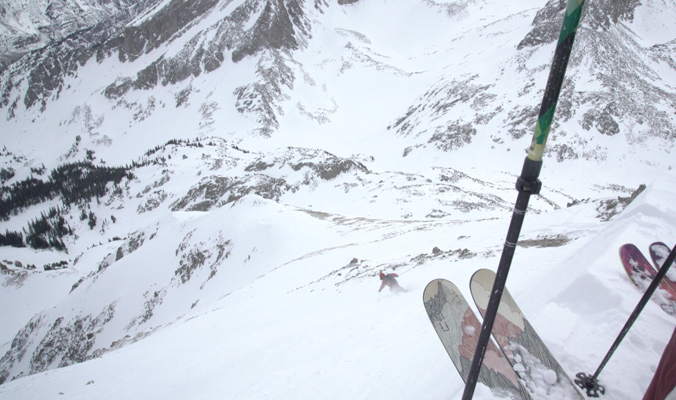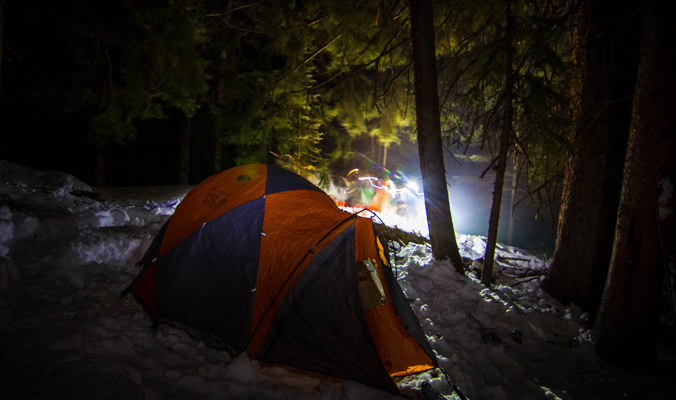At the end of February, there was a warming trend in the Rockies that, along with a stretch of no snow, provided uncharacteristic opportunities for skiers to get out and attempt certain lines that generally aren’t approachable until later in the spring.
For this reason, Aspen, Colo.-native Jacob O’Connor, along with his friends Devin Pool, Nikolas Anastas, Austin Johnson and Curtis Berklund, set out to ski a peak that O’Connor had been eyeing for a while. In view of Snowmass, Colo., Mt. Daly stands at just taller than 13,000 feet and is one among many towering peaks in the Elk Rand of the Maroon Bells Snowmass Wilderness.
Warm weather can create both problems and opportunities, so we were interested to hear more about a Mt. Daly summit in the middle of winter. Here’s what O’Connor had to say.
![The Mt. Daly approach. [Photo] Jacob O'Connor](https://backcountrymagazine.com/wp-content/uploads/2016/03/daly_embed_3.jpg)
The Mt. Daly approach. [Photo] Jacob O’Connor
Jacob O’Connor: Mt. Daly is a prominent peak that you can see from Snowmass Village. It is right there staring you in the face, so it has always been a goal of mine [to make a ski descent there]. It was pretty easy to convince my friends to do this with me because it is in view from where I live and the conditions permitted.
BCM: How trafficked is the mountain because of its visibility from Snowmass?
JC: Given its long approach, not many people summit it even in the summer.

Austin, Curtis and Jacob cross a river on the approach to Mt. Daly. [Photo] Devin Pool
JC: The approach was actually a bit easier because we were able to skin the entire way. Usually you have to hike in until you reach snow. There was one creek crossing we had to navigate.
I know we were traveling at the very end of February, but the conditions were more comparable to April. In Colorado we really struggle [in the middle of winter] with persistent weak layers. There is a huge variability in temperatures up high, we get a lot of sunshine and it is dry. So all those factors can lead to instability. Where we were planning to ski on Mt. Daly was the northeastern aspect and that is usually the area that takes the most time to consolidate. But, because of the warm temperatures and lack of new snow, we were able to avoid those persistent slabs.

Nikolas and Curtis bootpack up the East Couloir. [Photo] Jacob O’Connor
JC: Things were definitely consolidated on the way up. In the couloir where we skied, it was very wind-affected and sun-affected. Basically it was really crusty—crusty on top with a little bit of sugar underneath—but it was such a shallow snowpack that nothing was moving. We dug pits and tested the snowpack as we went up and nothing was propagating, nothing was whoomphing.
BCM: What was the line you skied?
JC: We skied the East Couloir on skiers’ right from the summit. You can ski the face of Mt. Daly, but that aspect is very exposed, and because it was our first time being back there we didn’t want to jump into that line. We had a lot of beta from our friends who had skied Mt. Daly last spring and said that the East Couloir was an estimated 40-degree pitch consistently all the way to the top.
On the approach you get up into the basin that is a massive avy path. You can see as you are going through that there is no vegetation. So, you get up into the basin and you start to transition to a bootpack up the couloir. It takes about two hours from the start of the bootpack to the top of the couloir. From there it is a short 20 or 30 minutes to the summit.
We skied right from the summit down the face a bit and then made a right turn into the entrance of the couloir.

Austin skis the face of Mt. Daly from the summit. [Photo] Nikolas Anastas
JC: Yeah, so there were five of us and we had a couple of winter tents. It was a little rough getting the boots on in the morning, but it was fun. It is only around five or six miles from trailhead to the summit, but about 5,000 feet of elevation. So, if you want to do it in one day you would have to start at midnight because you need to be at the summit by 9:30 a.m.
We had quite a bit of cloud cover and it was cold and windy up top so it never really softened up, but we felt confident in our drop time.
It is a pretty isolated part of the Elk Range. That is why so few people go up there even in the summer, but it is outrageously beautiful. You can see every 14er in the Elks. There was one of the best views of Capitol Peak I have ever seen.

Lodging for the night. [Photo] Devin Pool
JC: Definitely, just given these conditions, I am already thinking of another possibility. I’d like to ski some other 13ers in the area. I might have to wait longer to be sure, but I would like to ski Pyramid Peak, too, which is actually a 14er.









Awesome article!